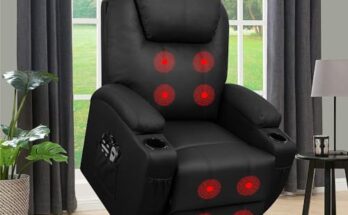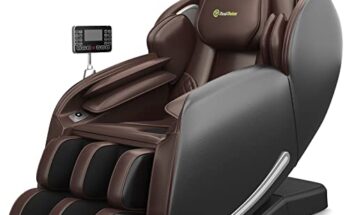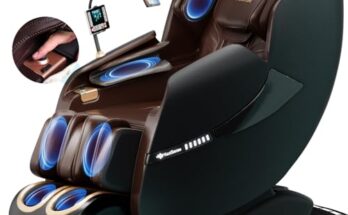A massage chair motor powers the rollers and nodes that knead and press on muscle tissues. It controls their movements to simulate various massage techniques.
Massage chairs offer a convenient way to unwind and provide relief from muscle tension at the touch of a button. As critical components, the motors inside these chairs are sophisticated and designed for durability, ensuring users experience a range of motions that mimic the hands of a skilled masseur.
From Shiatsu to Swedish techniques, these motors facilitate the intricate movements necessary to soothe sore muscles. Users seeking relaxation and therapeutic benefits often turn to these advanced pieces of furniture for regular sessions, contributing to the growing popularity of home massage equipment. Ensuring these chairs work effectively, the motors remain one of the pivotal elements, directly affecting the quality and type of massage delivered.

Credit: www.amazon.com
The Mechanics Of Comfort
The Mechanics of Comfort go beyond fluffy pillows or soft music. In today’s world, relaxation intertwines with technology, particularly in the form of a massage chair. These chairs are a marvel of engineering, designed to mimic human touch and provide relief and relaxation. To understand how instant comfort is delivered at the push of a button, it’s essential to unravel the mechanics of a massage chair.
Core Components Of A Massage Chair
Within the cozy confines of a massage chair lie various components working in harmony. Key elements include:
- Rollers and Nodes: They mimic the hands of a masseuse.
- Heating Elements: They add warmth to soothe muscles.
- Vibration Systems: These shake away your stress.
- Airbags: Inflate and deflate for pressure massage.
- Control Modules: The brain behind operation.
- Frames and Tracks: The skeleton that guides the rollers.
Role Of Motors In Massage Chairs
Imagine a conductor of an orchestra; motors play a similar role in massage chairs. Let’s break it down:
- Reclining: Motors adjust the chair for perfect positions.
- Movement: They guide the rollers along tracks.
- Intensity: They control pressure for a gentler or firmer massage.
A chair has multiple motors, each assigned to different tasks. A main motor drives the rollers across your back. Another motor may inflate airbags for an arm massage. These motors talk to the control module, which manages all operations. The perfect massage relies on their seamless interaction.
Diving Into The Motor Function
Have you ever wondered what makes a massage chair so relaxing? At the heart of this soothing experience is the motor function. Let’s explore how these motors bring your massage chair to life.
Types of Motors UsedTypes Of Motors Used
Massage chairs employ various motors for different purposes. Each type has unique benefits.
- AC Motors: Ideal for constant speed.
- DC Motors: Offer variable speed controls.
- Stepper Motors: Precise movement for targeted massage.
Translating Electrical Energy To Mechanical Movement
Motors in your massage chair turn electricity into movement. They do this in a few steps:
- Activating the Motor: Electricity starts the motor.
- Magnet Interaction: Magnets inside create motion.
- Gearing Systems: These systems control speed and torque.
The Interplay Of Electronics
Imagine sitting back in a massage chair. Think about the ripple of relaxation as motors power the rollers to soothe your muscles. This is possible thanks to complex electronics that work seamlessly behind the scenes. Let’s dive into how these systems interact to bring you blissful relaxation.
Circuitry And Control Systems
The heart of a massage chair’s functionality lies in its circuitry and control systems. These elements form a network that dictates the operation of the chair. Consider the following points:
- Power Source: Electrical energy flows from your home outlet through the chair’s wiring.
- Main Circuit Board: This is the brain of the massage chair. It processes inputs and sends out commands.
- User Interface: Buttons or a touchscreen allow you to customize your massage experience.
Sensors And Response Mechanisms
Sensors are vital in tailoring the massage to your body’s needs. They detect pressure, position, and movement. The massage chair then adjusts its response accordingly. Here are key aspects:
- Pressure Sensors: These gauge how much force the rollers should apply to different muscle groups.
- Motion Sensors: They track the position of the rollers and the recline angle of the chair.
- Feedback Loops: The chair uses sensor data to adapt the massage intensity in real time.
| Component | Function |
|---|---|
| Circuit Board | Interprets user input and coordinates massage movements. |
| Sensors | Provide feedback to ensure the massage is comfortable and effective. |
Together, the circuitry and sensors play a pivotal role in delivering a personalized massage experience that feels like it’s being performed by human hands.

Credit: www.nfm.com
Customization And Control
Massage chairs are not just about providing relief and relaxation. They offer a personalized experience, thanks to advanced motor controls and customization features. Let’s explore how these technological marvels let users tailor their massage sessions for an optimal experience.
User Interfaces
Modern massage chairs boast intuitive user interfaces, allowing for seamless operation. Users can choose preferred settings quickly and effortlessly. Typically, these interfaces include:
- Touchscreen panels: Convenient and user-friendly.
- Remote controls: Provide easy access to all features.
- Voice commands: Offer hands-free adjustments.
- Smart app integration: Enable control from smartphones.
Programming Varieties Of Massage Routines
Personalization is central to the massage chair experience. Users can program a variety of routines, such as:
- Shiatsu: Emulates the traditional Japanese technique.
- Swedish: Provides a gentler, soothing massage.
- Deep tissue: Targets deeper muscle layers for tension relief.
- Custom routines: Allows for the creation of a personalized massage sequence.
These routines are readily accessible and can be saved for future use, ensuring that users can enjoy their favorite massages anytime.
Maintenance And Longevity
Maintaining a massage chair is essential for its longevity.
Routine care can extend your chair’s life and performance.
Understanding the motor, the heart of the chair, is crucial.
Caring For Your Massage Chair Motor
Proper maintenance is key to keeping your massage chair’s motor in top condition.
- Regular Cleaning: Keep the motor free from dust and debris.
- Check Connections: Make sure wires and connectors are tight and secure.
- Lubrication: Some motors need periodic lubrication. Check your manual.
By following the guidelines, your massage chair motor remains robust.
Common Issues And Troubleshooting
Massage chair motors can face some issues.
Understanding these problems can help you react quickly and efficiently.
| Issue | Solution |
|---|---|
| Motor not running | Check power supply and fuse. Reset if necessary. |
| Noisy operation | Inspect for loose parts or obstructions. |
| Uneven movement | Ensure all gears and belts are in place and intact. |
For persistent issues, seek professional help or contact customer support.

Credit: www.slocog.org
Frequently Asked Questions For How A Massage Chair Motor Works
What Motors Are Used In Massage Chairs?
Massage chairs typically use a combination of DC motors for the massage rollers and mechanisms, and AC motors for reclining functions and adjustments.
Why Is The Motor Not Working On My Massage Chair?
Your massage chair motor may not be working due to a power issue, a blown fuse, or a malfunctioning motor. Check the power supply, reset the fuse, and consult the manual or a professional for motor-related troubleshooting.
How Does Chair Massage Work?
Chair massage targets the upper body, including the back, shoulders, neck, and arms. A therapist uses a special chair to perform quick, on-the-spot massages, usually lasting 15-30 minutes, aimed at providing immediate relief and relaxation.
What Is The Mechanism Of Massager?
Massagers typically use mechanisms like vibration, rolling, percussion, or kneading to stimulate muscles and promote relaxation. They alleviate tension by targeting tissue with pressure and movement.
Conclusion
Understanding the mechanics of a massage chair motor can enhance your appreciation for this innovative relaxation aid. These intricate devices combine electrical and mechanical components to replicate therapeutic massage techniques. As you select or use your massage chair, recognizing the sophisticated work of the motor systems deepens your experience, ensuring tranquility with every use.
Empower your restful moments with this knowledge in hand.


